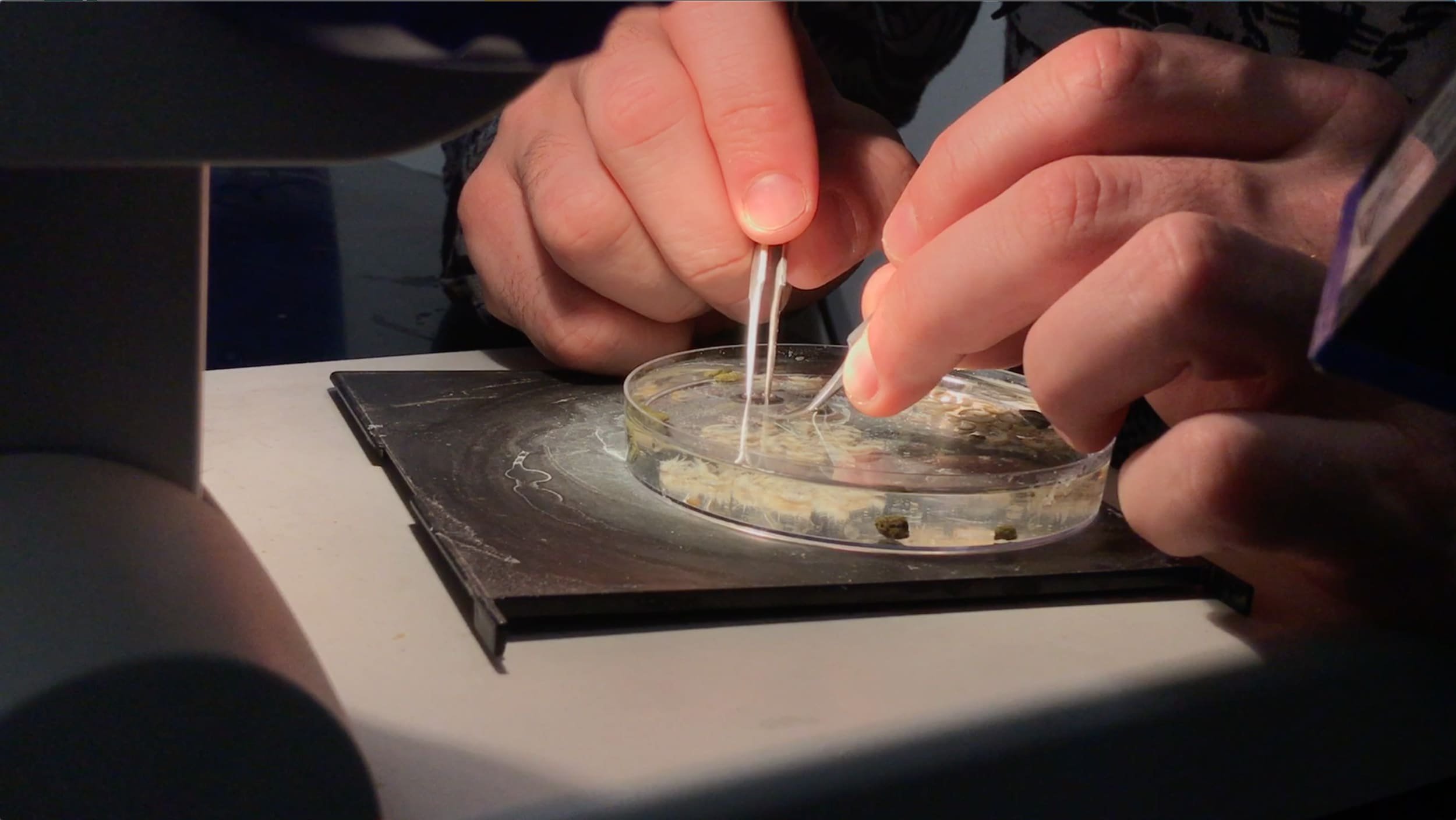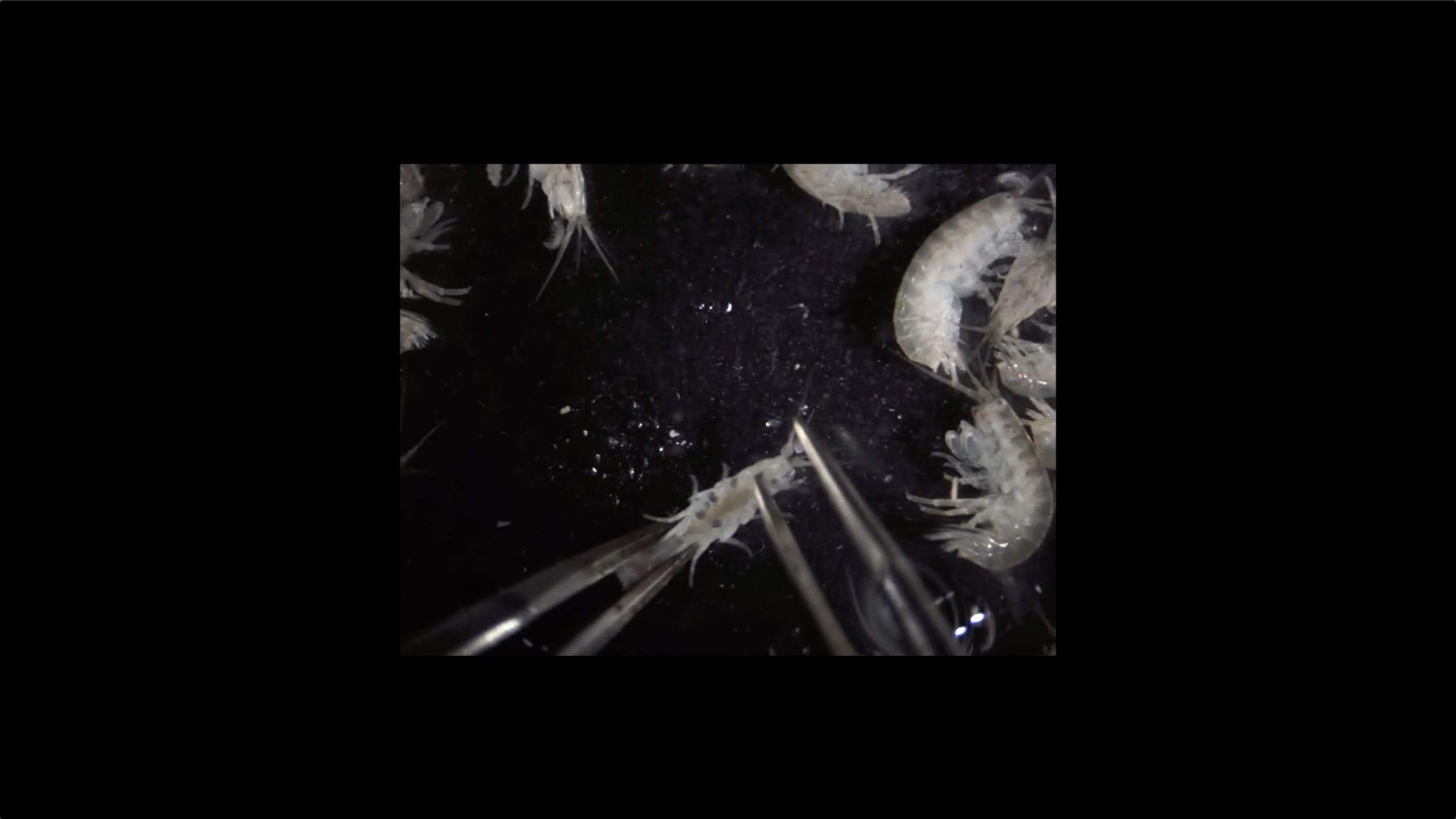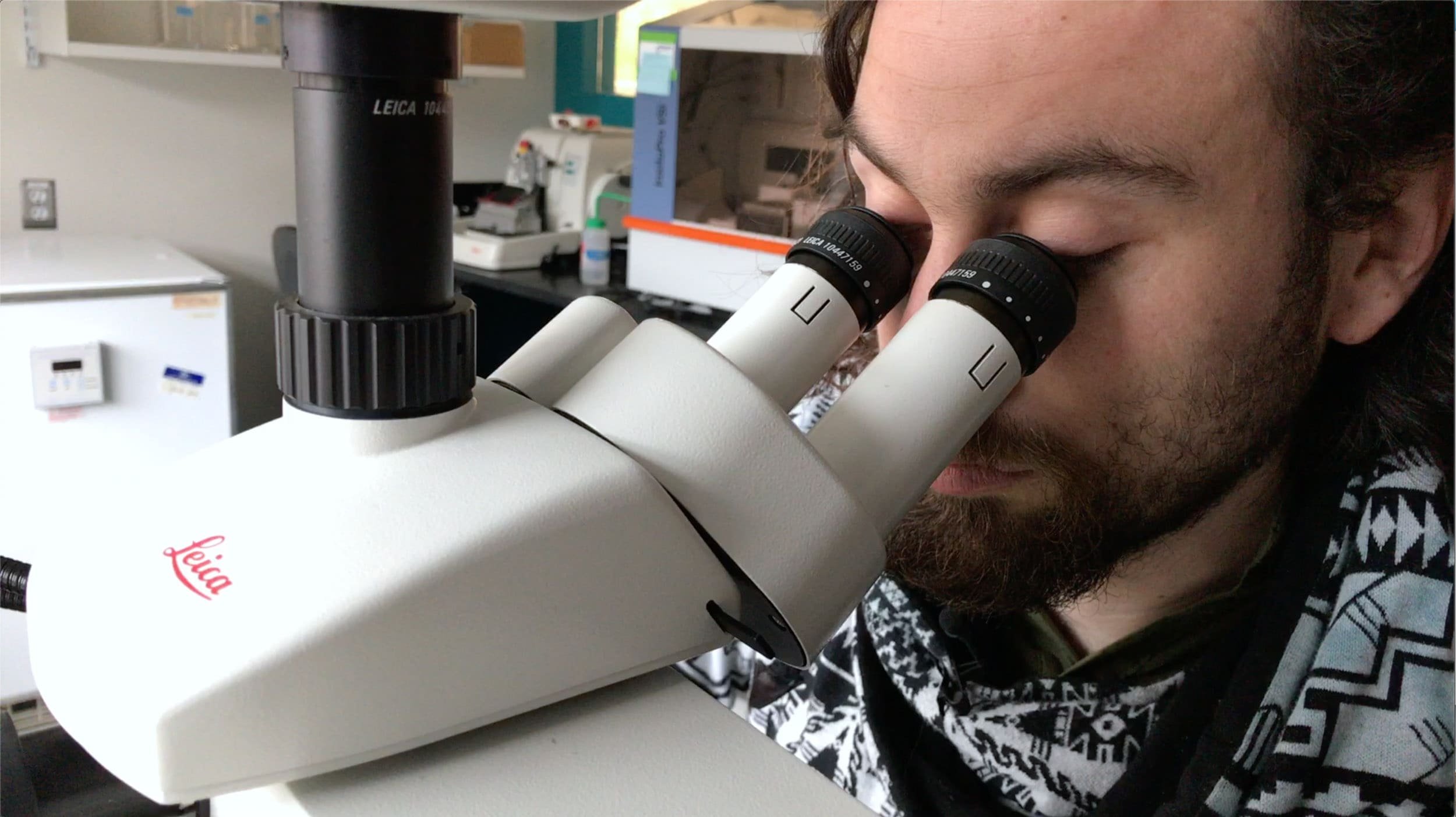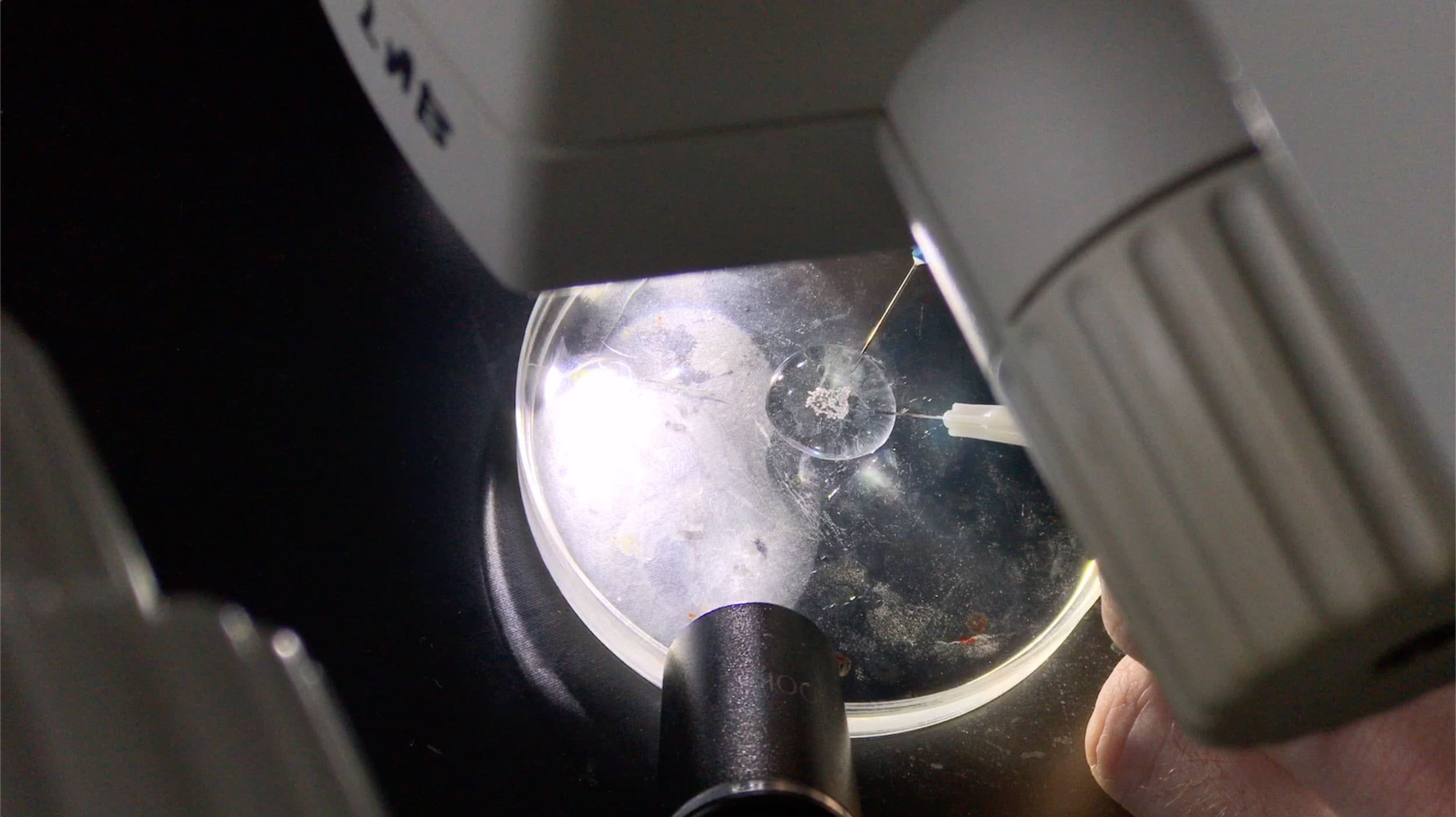Medium
Medium is a meditation on scale, process, and cellular life from the perspective of a biologist, Leo Blondel, as he dissects embryos of a marine crustacean. Straddling the micro and macro worlds, the film centers Leo's experience working under the microscope.
Written, directed, and produced by Beatrice Steinert, 2019
Premiered at the Science New Wave Film Festival, Cambridge, MA / 2021
Medium can be streamed at Labocine.com
On Medium
Leo: Your brain doesn’t know how to register this motion correctly at the beginning. And then you just do it one hundred, two hundred, three hundred times. And eventually, your brain starts to be like “okay, yeah, I get it.” As long as you are able to keep your body stable, it really doesn’t do much.
Many of the questions I asked Leo about his experience microdissecting grappled with scales of sensation: how do you so precisely manipulate such small tissues with your hands? What does it feel like to interact with microscopic objects? Leo responded: the microscopic scale of what you see and the macroscopic scale of what you feel do not line up. While you have visually entered one realm, the rest of your senses remain in the other.
Medium’s perspective oscillates between seeing Leo—his hands, fingers, and sometimes his face—and seeing what Leo sees—the tips of his dissecting needles interfacing with the tissues he manipulates. What appear as dramatic movements in the microscopic realm look extraordinarily minute when the camera’s view shifts to frame his hands. With a stabilized body in place, it is only through many hours of practice, repeating the same motions “one hundred, two hundred, three hundred times,” that biologists eventually learn to operate within the medium, the position in between human and cellular scales.
Leo: Most of the multicellular life around us, which is a lot of what we can see at the macro level—plants, trees, birds, animals. We all started from an embryo. The unit of life is the cell. Those units they interact with each other and through those interactions you arrive at many different cell types, tissues, nerves, nerve systems. A whole organism. That complexity is what we try to understand.
When we talk about an artistic medium—painting, ceramics, drawing, weaving—we are often referring simultaneously to materials with distinct and consequential properties and the process by which those materials are manipulated, either with hands or tools. Cells constitute both life's physical and structural manifestations. The interactions between the two are what bring about living processes. Each cell in an embryo is a physical and conceptual unit, a building block, and also something whose identity only emerges in relation to and in interaction with the other cells around it.
These notions of life stretch back to the first generalized theories of the cell. In the late 1830s, German biologists Mathias Schleiden and Theodor Schwann concluded that all organisms are made up of cells from their observations of morphological similarities among plant and animal tissues. Schleiden and Schwann’s conceptualization of the cell was primarily structural; each cell was an “independent, separate being,” a materially defined unit.[1] Together, like individual bricks form a building, these cellular units make up the organism. Over a decade later, British embryologist Thomas Henry Huxley offered an alternative view. In his critique of German cell theory, which he saw as too reductionist, Huxley foregrounded the “inherent law of change” as that which distinguished living beings.[2] Understanding multicellular life involved examining “the manner in which the successive anatomical states [of living beings] are related to, and proceed out of, one another.”[3] These successive states arose out of the forces and interactions of the matter of life, namely the masses of “protoplasm” that we now recognize as cells.[4]
Modern day conceptions of the cell encompass both of these early theoretical frameworks. As Leo notes, cells are recognizable units. An embryo, like the adult organism it will ultimately become, is made up of many different kinds of units: cells make up tissues, which form organs and bodily systems. However, those units are constantly in flux, both with regards to their shape and identity, as a result of their interactions with other cells. Understanding the life of an embryo, Leo’s motivation for his practice, involves parsing its cellular medium—its material units and lively processes.
Leo: I’m dissecting embryos into cells in order to flow them into a machine that will allow me to read their transcriptome. That’s a medium, that’s a technique. It’s the same as learning to paint. To paint, you can’t just take a brush and paint. I mean you can. But if you want to produce a piece of art that you’re happy with, then you usually need to learn how to use a brush—how to hold a brush, how much paint to put on the brush.
Just like an artist, Leo remarks, a scientist must choose a medium and master it to achieve an idea or address a set of questions. In this moment, microdissection is his medium. In order to understand Parhyale development, he breaks apart embryos so that he can sequence the transcriptome, all of the strands of RNA that have been transcribed from DNA, of the individual cells that constitute them. Collecting and dissecting embryos is the first step of the larger experiment that Leo is carrying out. After he removes the protective coating from several embryos at approximately the same stage, depicted in the film, he collects the dissociated embryonic cells and flows them through a microfluidic device. Each cell is individually captured and subsequently sequenced. Ultimately, Leo hopes, this medium will allow him to understand more about fluctuating embryonic cell identities; it is the means through which Leo can “read” cells in order to see what genes each expresses at particular developmental time points. Achieving this knowledge involves mastering technique. Just like a painter skillfully and precisely controls a brush in order to create an image, Leo manipulates delicate microscopic needles in order to learn something new about Parhyale embryonic life.
This mastery of artful technique is situated within a long lineage of experimental embryology that stretches back over a century. Reflecting on his experience as a young student in the first decades of the twentieth century, the embryologist Viktor Hamburger recalls marveling at “the elegance and superb craftsmanship in the performance of the masters of this art.”[5] The experimental manipulation of living embryos was a novel approach within the field of embryology during this period, and its progression according to Hamburger “depended as much on the refinement of techniques as the ability to ask the right questions.”[6] As Leo demonstrates, coming up with creative questions or potent ideas is certainly important, but it will only get you so far. Testing those ideas by materializing them through practice is the other side of the coin.
Leo: It entails creativity, patience, tenacity. And craziness—yeah, definitely go with craziness. But that’s my judgment. I don’t have any data to prove it, just my life.
[1] Theodor Schwann, M. J. Schleiden, and Henry Smith, Microscopical Researches into the Accordance in the Structure and Growth of Animals and Plants. (London,: The Sydenham Society, 1847).
[2] Thomas Henry Huxley. “The Cell-Theory.” British and Foreign Medico-Chirurgical Review 12 (1853): 286.
[3] Ibid, 287.
[4] Marsha L. Richmond, “T.H. Huxley’s Criticism of German Cell Theory: An Epigenetic and Physiological Interpretation of Cell Structure,” Journal of the History of Biology 33, no. 2 (September 1, 2000): 247–89.
[5] Viktor Hamburger, The Heritage of Experimental Embryology: Hans Spemann and the Organizer, Monographs on the History and Philosophy of Biology (New York: Oxford University Press, 1988), vii.
[6] Ibid, 5.



